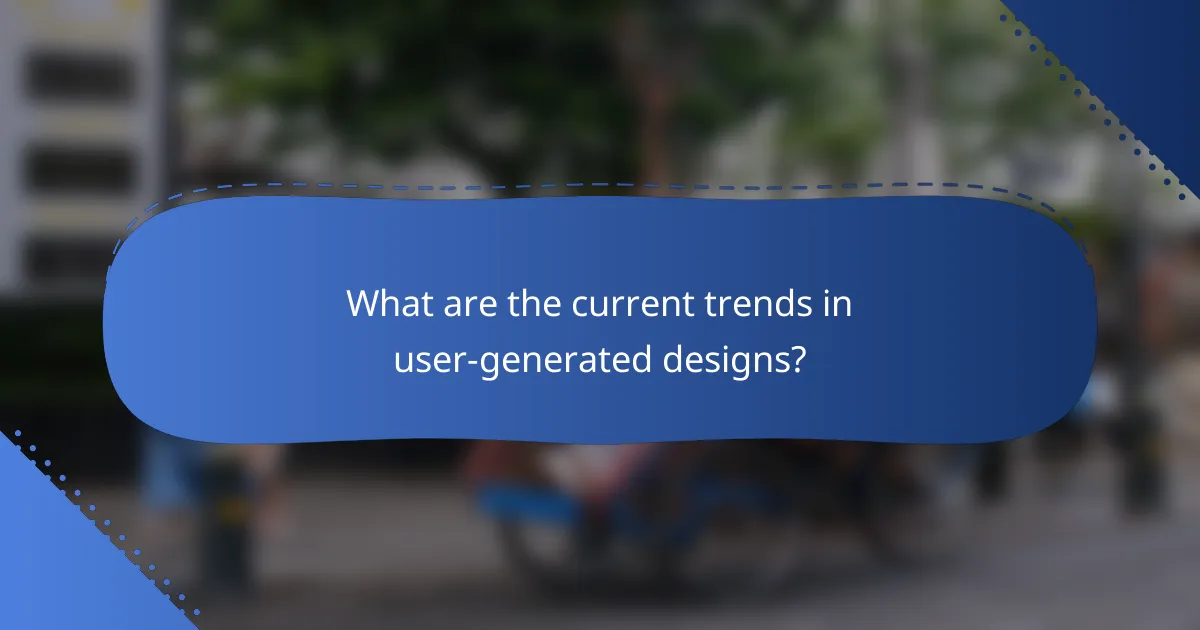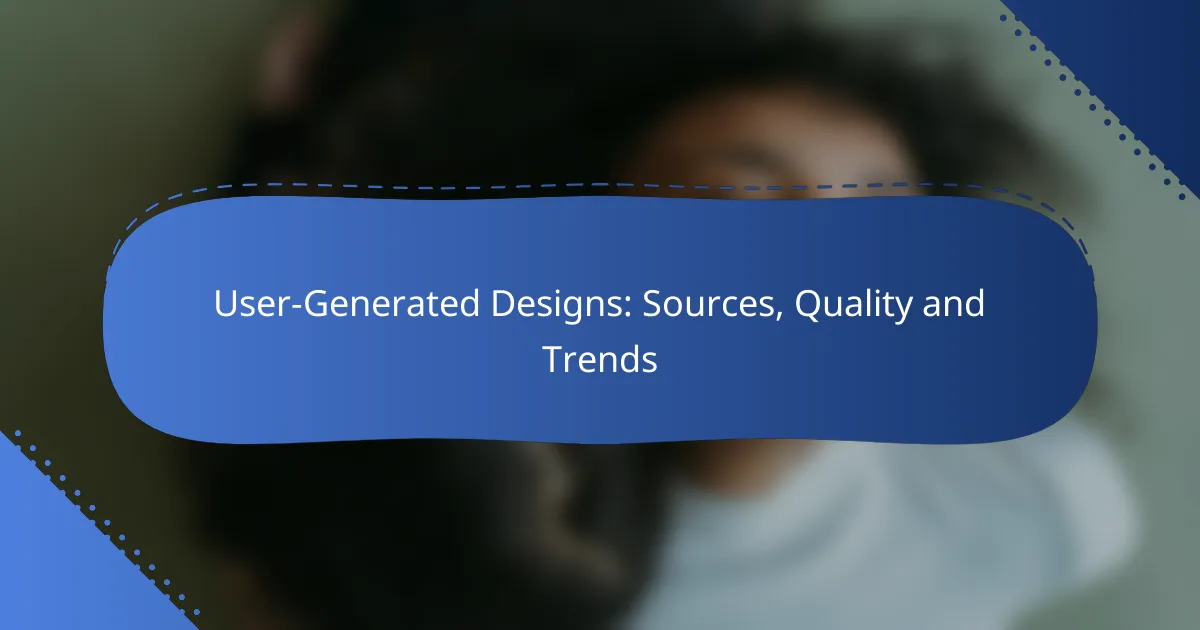User-generated designs have become a vital part of the creative landscape, with social media platforms, design marketplaces, and online communities serving as key sources for innovative ideas. Evaluating the quality of these designs involves considering user reviews and professional endorsements, which highlight their effectiveness and appeal. Current trends showcase a focus on minimalist aesthetics, sustainability, and technology integration, reflecting a growing demand for personalized and interactive experiences.

What are the best sources for user-generated designs?
The best sources for user-generated designs include social media platforms, design marketplaces, online communities, and creative forums. Each of these platforms offers unique opportunities for discovering innovative designs and connecting with creators.
Social media platforms like Instagram
Instagram is a powerful platform for user-generated designs, showcasing a vast array of creative work. Users can explore hashtags related to design, such as #graphicdesign or #illustration, to find inspiration and connect with designers directly.
To effectively use Instagram for design inspiration, follow accounts that align with your aesthetic and engage with their content. This can lead to discovering emerging trends and styles that resonate with your own design needs.
Design marketplaces such as Etsy
Etsy is a popular marketplace for unique, handmade, and user-generated designs, particularly in crafts, art, and home decor. It allows designers to sell their work directly to consumers, fostering a community of creative entrepreneurs.
When browsing Etsy, consider filtering by customer reviews and sales numbers to gauge the quality of designs. This can help you find reputable sellers and ensure you are purchasing high-quality products.
Online communities like Behance
Behance is an online platform where designers can showcase their portfolios and connect with other creatives. It features a wide range of design categories, making it easy to find user-generated work that fits specific interests.
To make the most of Behance, create an account to follow favorite designers and receive updates on their new projects. This engagement can provide ongoing inspiration and insights into current design trends.
Creative forums and subreddits
Creative forums and subreddits, such as r/Design or r/graphic_design, offer spaces for designers to share their work, seek feedback, and discuss trends. These platforms are valuable for networking and gaining insights from a diverse community of creators.
Participating in discussions and sharing your own designs can enhance your visibility and help you learn from others’ experiences. Be mindful of community guidelines to ensure constructive engagement and avoid common pitfalls.

How to evaluate the quality of user-generated designs?
To evaluate the quality of user-generated designs, focus on user reviews, professional endorsements, and the design’s consistency and originality. These factors can provide insights into the design’s effectiveness and appeal, helping you make informed decisions.
Assessing user reviews and ratings
User reviews and ratings are crucial indicators of design quality. Look for designs that have a high number of positive reviews, ideally with an average rating above four stars. Pay attention to the content of the reviews; detailed feedback often reveals strengths and weaknesses that numerical ratings may not capture.
Consider the recency of the reviews as well. Designs with consistent positive feedback over time are likely to maintain quality, while a sudden influx of negative reviews may signal emerging issues. Aim to read a mix of reviews to get a balanced perspective.
Checking for professional endorsements
Professional endorsements can significantly enhance the credibility of user-generated designs. Look for designs that have been featured or recommended by industry experts, design blogs, or reputable platforms. Such endorsements often indicate a level of quality that has been vetted by knowledgeable sources.
Additionally, check if the design has won any awards or recognitions in design competitions. Awards can serve as a benchmark for quality and originality, providing further assurance of the design’s value.
Examining design consistency and originality
Consistency in design elements is essential for creating a cohesive user experience. Evaluate whether the design maintains a uniform style, color palette, and typography throughout. A well-executed design should feel harmonious and intentional rather than disjointed.
Originality is equally important; unique designs often stand out and resonate more with users. Look for creative elements that differentiate the design from others in the same category. Avoid designs that appear overly derivative or lack innovation, as these may fail to capture user interest effectively.

What are the current trends in user-generated designs?
Current trends in user-generated designs emphasize creativity and community engagement, focusing on minimalist aesthetics, sustainability, and advanced technology integration. These trends reflect a shift towards more personalized and interactive experiences, driven by user preferences and technological advancements.
Minimalist and sustainable design approaches
Minimalist design prioritizes simplicity, functionality, and clean lines, often using a limited color palette. This approach not only enhances user experience but also reduces production costs and environmental impact, aligning with sustainability goals.
Designers are increasingly opting for eco-friendly materials and processes, which resonate with consumers’ growing awareness of environmental issues. For instance, using recycled materials or digital-only products can significantly lower carbon footprints.
Integration of augmented reality features
Augmented reality (AR) is becoming a key component in user-generated designs, allowing users to visualize products in their own environments. This technology enhances interactivity and engagement, making the design process more immersive.
For example, AR applications enable users to see how furniture fits in their homes before purchase, leading to more informed decisions. As AR technology becomes more accessible, its integration in user-generated designs is expected to grow.
Personalization and customization trends
Personalization in user-generated designs allows individuals to tailor products to their specific tastes and needs. This trend is driven by the demand for unique, one-of-a-kind items that reflect personal identity.
Customization options can range from color choices to design elements, enabling users to create products that resonate with them. Platforms that facilitate user input and feedback are essential for fostering this trend, ensuring that designs remain relevant and appealing.

What criteria should be used to select user-generated designs?
When selecting user-generated designs, focus on quality, relevance, and alignment with your brand’s identity. Evaluating these criteria ensures that the designs resonate with your target audience and uphold your brand’s values.
Target audience preferences
Understanding your target audience’s preferences is crucial for selecting user-generated designs that will engage them. Consider factors such as age, interests, and cultural background, as these can significantly influence design appeal. For example, vibrant colors and playful fonts may attract a younger demographic, while minimalist designs might resonate better with professionals.
Conduct surveys or analyze social media interactions to gather insights on what styles and themes your audience favors. This data can guide your selection process and help you choose designs that will likely be well-received.
Brand alignment and messaging
Ensure that user-generated designs align with your brand’s messaging and overall aesthetic. This alignment reinforces brand identity and fosters trust among consumers. For instance, if your brand promotes sustainability, designs that feature eco-friendly themes or materials will resonate more strongly with your audience.
Review the designs for consistency in tone, color palette, and visual elements that reflect your brand values. Avoid designs that deviate significantly from your established brand guidelines, as this can confuse your audience and dilute your messaging.

How do user-generated designs impact marketing strategies?
User-generated designs significantly influence marketing strategies by fostering a sense of community and authenticity. These designs, created by consumers, can enhance brand perception and drive engagement, making them a valuable asset for marketers.
Enhancing brand authenticity
User-generated designs contribute to brand authenticity by showcasing real customer experiences and creativity. When brands incorporate these designs into their marketing, they demonstrate trust in their audience, which can strengthen customer loyalty.
For example, a clothing brand that features customer-created designs in its campaigns can resonate more with its target market. This approach not only highlights the brand’s commitment to its community but also encourages more customers to participate in the design process.
Increasing customer engagement
Involving customers in the design process can significantly boost engagement levels. By encouraging users to submit their designs, brands create interactive experiences that invite participation and feedback.
Brands can implement design contests or social media challenges, where customers share their creations. This not only generates excitement but also increases brand visibility as participants share their designs with their networks, effectively expanding the brand’s reach.

What are the challenges of using user-generated designs?
User-generated designs can present various challenges, including quality control, intellectual property issues, and consistency in branding. These factors can significantly impact the overall effectiveness and perception of a brand’s visual identity.
Quality Control
Ensuring quality in user-generated designs is a primary challenge. Designs may vary widely in skill level, leading to inconsistencies that can confuse or alienate customers. Establishing clear guidelines and standards can help mitigate these issues.
To maintain quality, brands should implement a review process for submissions. This could involve peer reviews or expert evaluations to select the best designs that align with brand values. Providing constructive feedback can also encourage users to improve their submissions.
Intellectual Property Issues
User-generated designs often raise concerns regarding intellectual property rights. Users may inadvertently use copyrighted materials, leading to potential legal disputes. Brands must educate users about copyright laws and the importance of originality.
To protect both the brand and the contributors, it’s advisable to have clear terms of use that outline ownership rights and usage permissions. This can help prevent misunderstandings and ensure that all parties are aware of their rights and responsibilities.
Consistency in Branding
Maintaining a consistent brand image can be difficult with user-generated content. Different styles and interpretations can dilute brand identity, making it essential to guide contributors on how to align their designs with the brand’s aesthetic.
Providing templates or style guides can help users create designs that fit within the desired brand framework. Regularly showcasing exemplary designs can also inspire users to adhere to brand standards while still allowing for creativity.
